Why Managers Should Prioritize Effective Communication: ABC Company
VerifiedAdded on 2023/06/04
|26
|6830
|348
Report
AI Summary
This report, prepared for the CEO of ABC Company, investigates why managers should prioritize effective communication within the organization. It comprehensively examines three key areas: the personal and interpersonal aspects of communication, including persuasion, personal networks, and grapevine communication; the formal and informal communication channels (downward, upward, and horizontal) used within the organization; and crisis communication, including the development of strategies to protect the organization's reputation. The report emphasizes the importance of communication as a vital component of an organization's overall strategy, providing real-world examples and actionable strategies to help managers navigate communication challenges, build strong relationships, and effectively manage crises. The report concludes by reinforcing the necessity of managers giving equal importance to communication as they do to other aspects of the organization.

Running head: MANAGERS SHOULD MAKE EFFECTIVE COMMUNICATION A PRIORITY
MANAGERS SHOULD MAKE EFFECTIVE COMMUNICATION A PRIORITY
Name of the student
Name of the university
Author note
MANAGERS SHOULD MAKE EFFECTIVE COMMUNICATION A PRIORITY
Name of the student
Name of the university
Author note
Paraphrase This Document
Need a fresh take? Get an instant paraphrase of this document with our AI Paraphraser
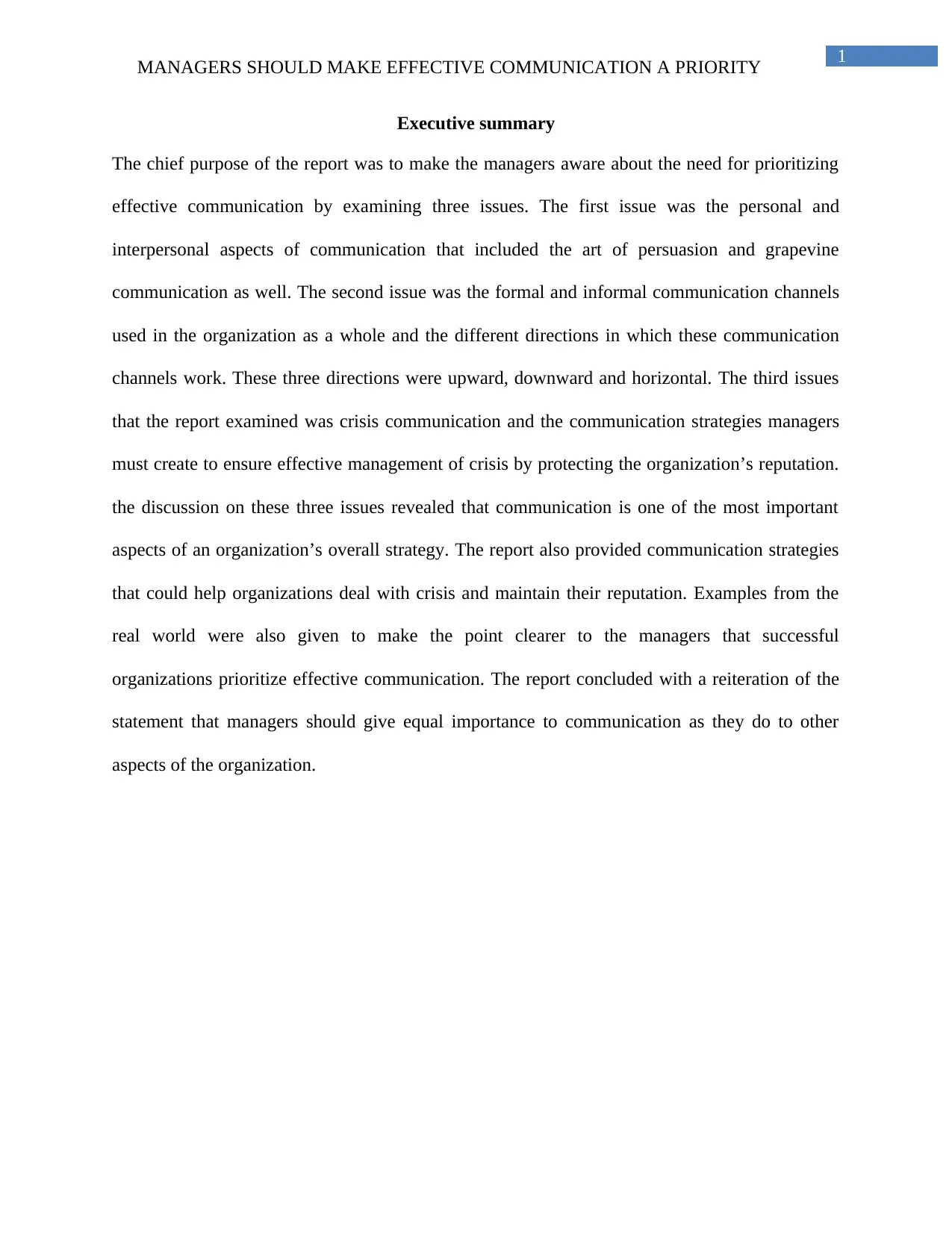
1
MANAGERS SHOULD MAKE EFFECTIVE COMMUNICATION A PRIORITY
Executive summary
The chief purpose of the report was to make the managers aware about the need for prioritizing
effective communication by examining three issues. The first issue was the personal and
interpersonal aspects of communication that included the art of persuasion and grapevine
communication as well. The second issue was the formal and informal communication channels
used in the organization as a whole and the different directions in which these communication
channels work. These three directions were upward, downward and horizontal. The third issues
that the report examined was crisis communication and the communication strategies managers
must create to ensure effective management of crisis by protecting the organization’s reputation.
the discussion on these three issues revealed that communication is one of the most important
aspects of an organization’s overall strategy. The report also provided communication strategies
that could help organizations deal with crisis and maintain their reputation. Examples from the
real world were also given to make the point clearer to the managers that successful
organizations prioritize effective communication. The report concluded with a reiteration of the
statement that managers should give equal importance to communication as they do to other
aspects of the organization.
MANAGERS SHOULD MAKE EFFECTIVE COMMUNICATION A PRIORITY
Executive summary
The chief purpose of the report was to make the managers aware about the need for prioritizing
effective communication by examining three issues. The first issue was the personal and
interpersonal aspects of communication that included the art of persuasion and grapevine
communication as well. The second issue was the formal and informal communication channels
used in the organization as a whole and the different directions in which these communication
channels work. These three directions were upward, downward and horizontal. The third issues
that the report examined was crisis communication and the communication strategies managers
must create to ensure effective management of crisis by protecting the organization’s reputation.
the discussion on these three issues revealed that communication is one of the most important
aspects of an organization’s overall strategy. The report also provided communication strategies
that could help organizations deal with crisis and maintain their reputation. Examples from the
real world were also given to make the point clearer to the managers that successful
organizations prioritize effective communication. The report concluded with a reiteration of the
statement that managers should give equal importance to communication as they do to other
aspects of the organization.
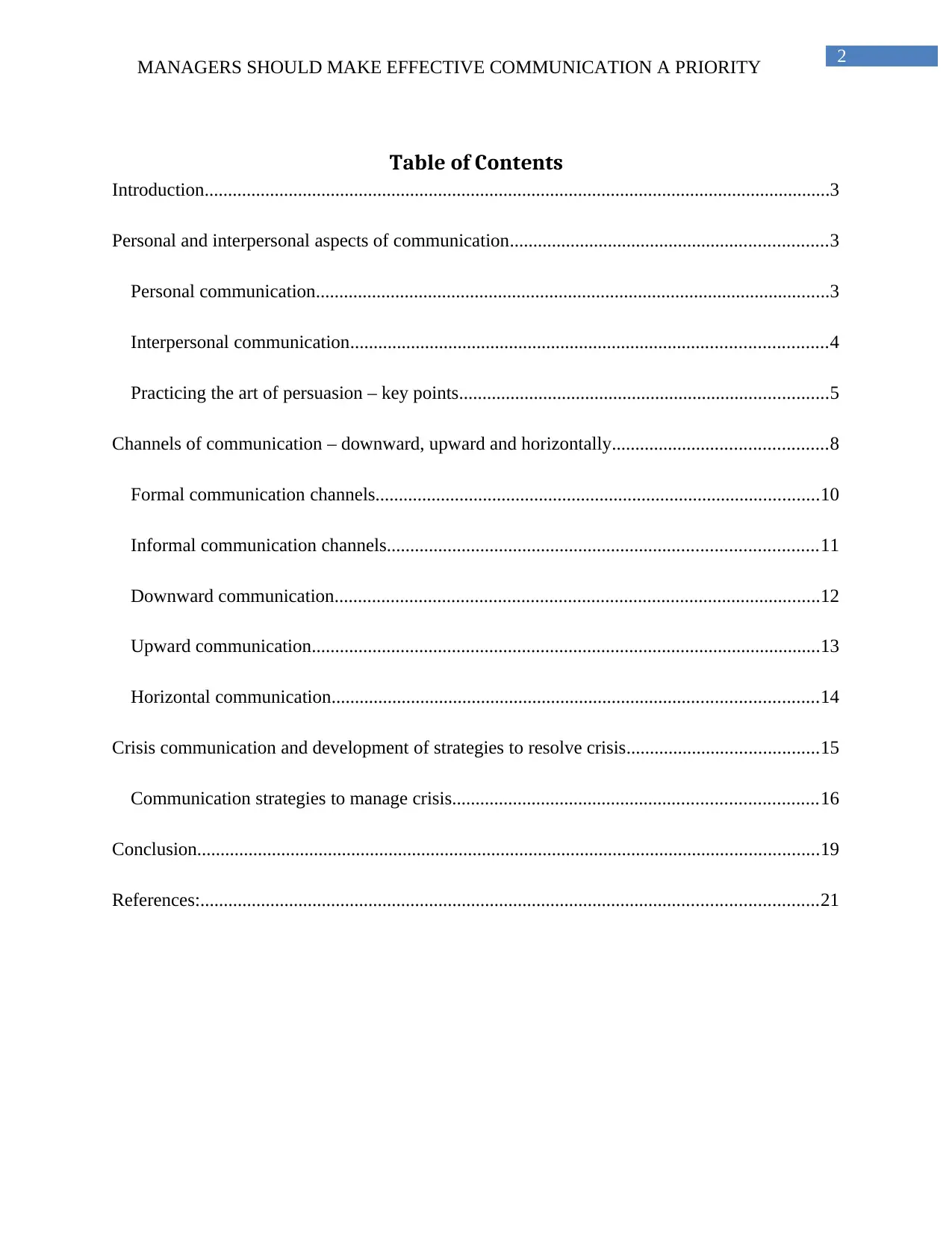
2
MANAGERS SHOULD MAKE EFFECTIVE COMMUNICATION A PRIORITY
Table of Contents
Introduction......................................................................................................................................3
Personal and interpersonal aspects of communication....................................................................3
Personal communication..............................................................................................................3
Interpersonal communication......................................................................................................4
Practicing the art of persuasion – key points...............................................................................5
Channels of communication – downward, upward and horizontally..............................................8
Formal communication channels...............................................................................................10
Informal communication channels............................................................................................11
Downward communication........................................................................................................12
Upward communication.............................................................................................................13
Horizontal communication........................................................................................................14
Crisis communication and development of strategies to resolve crisis.........................................15
Communication strategies to manage crisis..............................................................................16
Conclusion.....................................................................................................................................19
References:....................................................................................................................................21
MANAGERS SHOULD MAKE EFFECTIVE COMMUNICATION A PRIORITY
Table of Contents
Introduction......................................................................................................................................3
Personal and interpersonal aspects of communication....................................................................3
Personal communication..............................................................................................................3
Interpersonal communication......................................................................................................4
Practicing the art of persuasion – key points...............................................................................5
Channels of communication – downward, upward and horizontally..............................................8
Formal communication channels...............................................................................................10
Informal communication channels............................................................................................11
Downward communication........................................................................................................12
Upward communication.............................................................................................................13
Horizontal communication........................................................................................................14
Crisis communication and development of strategies to resolve crisis.........................................15
Communication strategies to manage crisis..............................................................................16
Conclusion.....................................................................................................................................19
References:....................................................................................................................................21
⊘ This is a preview!⊘
Do you want full access?
Subscribe today to unlock all pages.

Trusted by 1+ million students worldwide
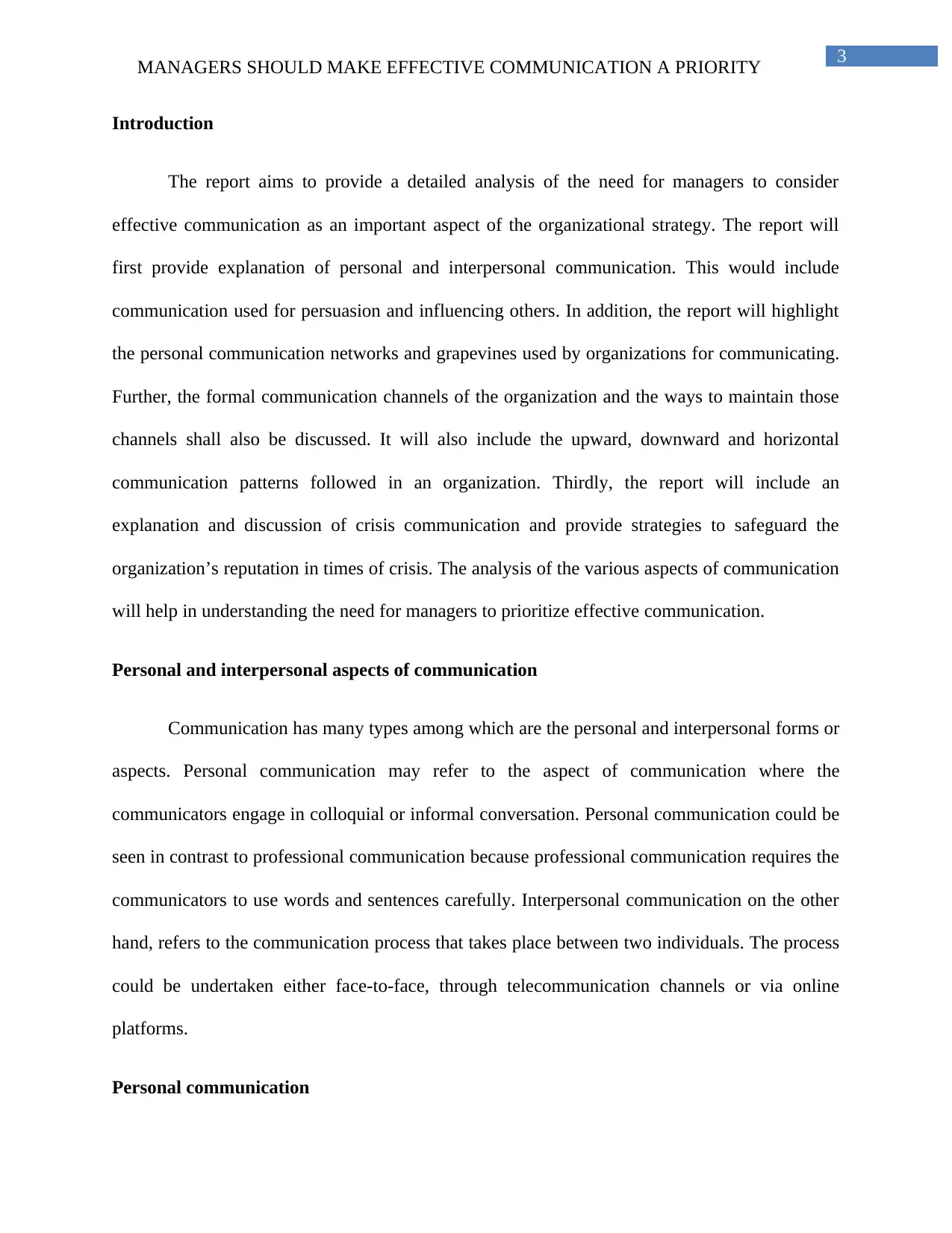
3
MANAGERS SHOULD MAKE EFFECTIVE COMMUNICATION A PRIORITY
Introduction
The report aims to provide a detailed analysis of the need for managers to consider
effective communication as an important aspect of the organizational strategy. The report will
first provide explanation of personal and interpersonal communication. This would include
communication used for persuasion and influencing others. In addition, the report will highlight
the personal communication networks and grapevines used by organizations for communicating.
Further, the formal communication channels of the organization and the ways to maintain those
channels shall also be discussed. It will also include the upward, downward and horizontal
communication patterns followed in an organization. Thirdly, the report will include an
explanation and discussion of crisis communication and provide strategies to safeguard the
organization’s reputation in times of crisis. The analysis of the various aspects of communication
will help in understanding the need for managers to prioritize effective communication.
Personal and interpersonal aspects of communication
Communication has many types among which are the personal and interpersonal forms or
aspects. Personal communication may refer to the aspect of communication where the
communicators engage in colloquial or informal conversation. Personal communication could be
seen in contrast to professional communication because professional communication requires the
communicators to use words and sentences carefully. Interpersonal communication on the other
hand, refers to the communication process that takes place between two individuals. The process
could be undertaken either face-to-face, through telecommunication channels or via online
platforms.
Personal communication
MANAGERS SHOULD MAKE EFFECTIVE COMMUNICATION A PRIORITY
Introduction
The report aims to provide a detailed analysis of the need for managers to consider
effective communication as an important aspect of the organizational strategy. The report will
first provide explanation of personal and interpersonal communication. This would include
communication used for persuasion and influencing others. In addition, the report will highlight
the personal communication networks and grapevines used by organizations for communicating.
Further, the formal communication channels of the organization and the ways to maintain those
channels shall also be discussed. It will also include the upward, downward and horizontal
communication patterns followed in an organization. Thirdly, the report will include an
explanation and discussion of crisis communication and provide strategies to safeguard the
organization’s reputation in times of crisis. The analysis of the various aspects of communication
will help in understanding the need for managers to prioritize effective communication.
Personal and interpersonal aspects of communication
Communication has many types among which are the personal and interpersonal forms or
aspects. Personal communication may refer to the aspect of communication where the
communicators engage in colloquial or informal conversation. Personal communication could be
seen in contrast to professional communication because professional communication requires the
communicators to use words and sentences carefully. Interpersonal communication on the other
hand, refers to the communication process that takes place between two individuals. The process
could be undertaken either face-to-face, through telecommunication channels or via online
platforms.
Personal communication
Paraphrase This Document
Need a fresh take? Get an instant paraphrase of this document with our AI Paraphraser
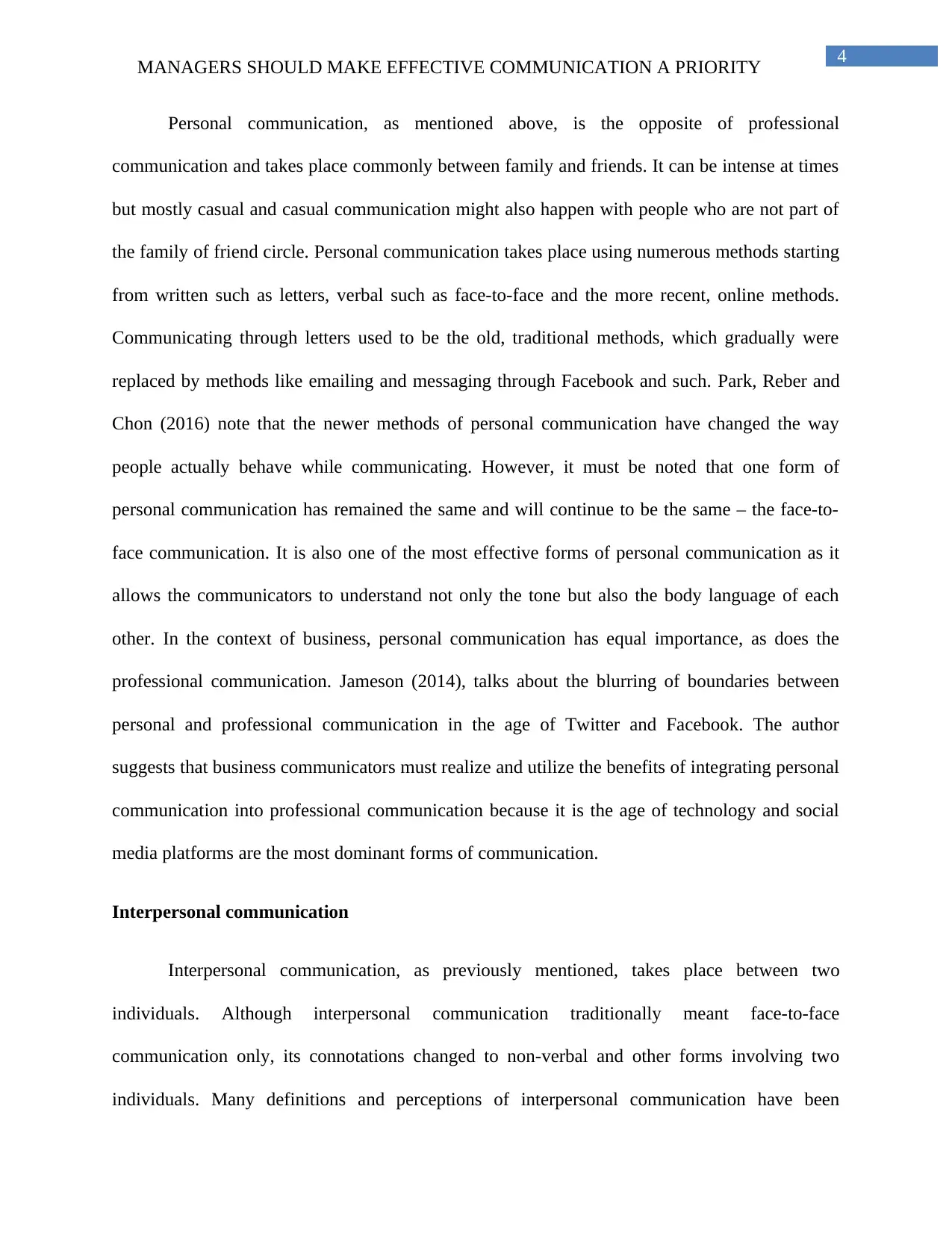
4
MANAGERS SHOULD MAKE EFFECTIVE COMMUNICATION A PRIORITY
Personal communication, as mentioned above, is the opposite of professional
communication and takes place commonly between family and friends. It can be intense at times
but mostly casual and casual communication might also happen with people who are not part of
the family of friend circle. Personal communication takes place using numerous methods starting
from written such as letters, verbal such as face-to-face and the more recent, online methods.
Communicating through letters used to be the old, traditional methods, which gradually were
replaced by methods like emailing and messaging through Facebook and such. Park, Reber and
Chon (2016) note that the newer methods of personal communication have changed the way
people actually behave while communicating. However, it must be noted that one form of
personal communication has remained the same and will continue to be the same – the face-to-
face communication. It is also one of the most effective forms of personal communication as it
allows the communicators to understand not only the tone but also the body language of each
other. In the context of business, personal communication has equal importance, as does the
professional communication. Jameson (2014), talks about the blurring of boundaries between
personal and professional communication in the age of Twitter and Facebook. The author
suggests that business communicators must realize and utilize the benefits of integrating personal
communication into professional communication because it is the age of technology and social
media platforms are the most dominant forms of communication.
Interpersonal communication
Interpersonal communication, as previously mentioned, takes place between two
individuals. Although interpersonal communication traditionally meant face-to-face
communication only, its connotations changed to non-verbal and other forms involving two
individuals. Many definitions and perceptions of interpersonal communication have been
MANAGERS SHOULD MAKE EFFECTIVE COMMUNICATION A PRIORITY
Personal communication, as mentioned above, is the opposite of professional
communication and takes place commonly between family and friends. It can be intense at times
but mostly casual and casual communication might also happen with people who are not part of
the family of friend circle. Personal communication takes place using numerous methods starting
from written such as letters, verbal such as face-to-face and the more recent, online methods.
Communicating through letters used to be the old, traditional methods, which gradually were
replaced by methods like emailing and messaging through Facebook and such. Park, Reber and
Chon (2016) note that the newer methods of personal communication have changed the way
people actually behave while communicating. However, it must be noted that one form of
personal communication has remained the same and will continue to be the same – the face-to-
face communication. It is also one of the most effective forms of personal communication as it
allows the communicators to understand not only the tone but also the body language of each
other. In the context of business, personal communication has equal importance, as does the
professional communication. Jameson (2014), talks about the blurring of boundaries between
personal and professional communication in the age of Twitter and Facebook. The author
suggests that business communicators must realize and utilize the benefits of integrating personal
communication into professional communication because it is the age of technology and social
media platforms are the most dominant forms of communication.
Interpersonal communication
Interpersonal communication, as previously mentioned, takes place between two
individuals. Although interpersonal communication traditionally meant face-to-face
communication only, its connotations changed to non-verbal and other forms involving two
individuals. Many definitions and perceptions of interpersonal communication have been
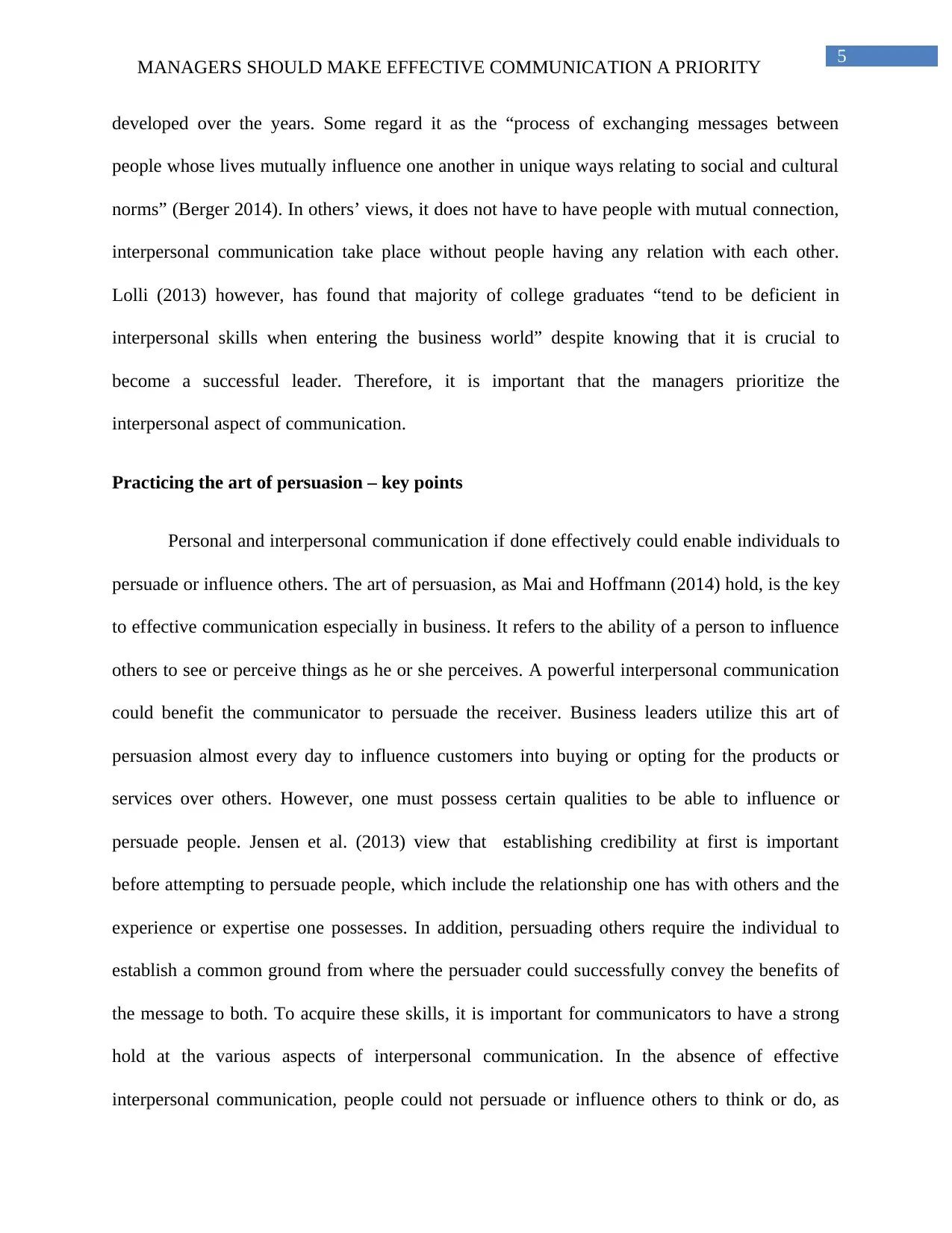
5
MANAGERS SHOULD MAKE EFFECTIVE COMMUNICATION A PRIORITY
developed over the years. Some regard it as the “process of exchanging messages between
people whose lives mutually influence one another in unique ways relating to social and cultural
norms” (Berger 2014). In others’ views, it does not have to have people with mutual connection,
interpersonal communication take place without people having any relation with each other.
Lolli (2013) however, has found that majority of college graduates “tend to be deficient in
interpersonal skills when entering the business world” despite knowing that it is crucial to
become a successful leader. Therefore, it is important that the managers prioritize the
interpersonal aspect of communication.
Practicing the art of persuasion – key points
Personal and interpersonal communication if done effectively could enable individuals to
persuade or influence others. The art of persuasion, as Mai and Hoffmann (2014) hold, is the key
to effective communication especially in business. It refers to the ability of a person to influence
others to see or perceive things as he or she perceives. A powerful interpersonal communication
could benefit the communicator to persuade the receiver. Business leaders utilize this art of
persuasion almost every day to influence customers into buying or opting for the products or
services over others. However, one must possess certain qualities to be able to influence or
persuade people. Jensen et al. (2013) view that establishing credibility at first is important
before attempting to persuade people, which include the relationship one has with others and the
experience or expertise one possesses. In addition, persuading others require the individual to
establish a common ground from where the persuader could successfully convey the benefits of
the message to both. To acquire these skills, it is important for communicators to have a strong
hold at the various aspects of interpersonal communication. In the absence of effective
interpersonal communication, people could not persuade or influence others to think or do, as
MANAGERS SHOULD MAKE EFFECTIVE COMMUNICATION A PRIORITY
developed over the years. Some regard it as the “process of exchanging messages between
people whose lives mutually influence one another in unique ways relating to social and cultural
norms” (Berger 2014). In others’ views, it does not have to have people with mutual connection,
interpersonal communication take place without people having any relation with each other.
Lolli (2013) however, has found that majority of college graduates “tend to be deficient in
interpersonal skills when entering the business world” despite knowing that it is crucial to
become a successful leader. Therefore, it is important that the managers prioritize the
interpersonal aspect of communication.
Practicing the art of persuasion – key points
Personal and interpersonal communication if done effectively could enable individuals to
persuade or influence others. The art of persuasion, as Mai and Hoffmann (2014) hold, is the key
to effective communication especially in business. It refers to the ability of a person to influence
others to see or perceive things as he or she perceives. A powerful interpersonal communication
could benefit the communicator to persuade the receiver. Business leaders utilize this art of
persuasion almost every day to influence customers into buying or opting for the products or
services over others. However, one must possess certain qualities to be able to influence or
persuade people. Jensen et al. (2013) view that establishing credibility at first is important
before attempting to persuade people, which include the relationship one has with others and the
experience or expertise one possesses. In addition, persuading others require the individual to
establish a common ground from where the persuader could successfully convey the benefits of
the message to both. To acquire these skills, it is important for communicators to have a strong
hold at the various aspects of interpersonal communication. In the absence of effective
interpersonal communication, people could not persuade or influence others to think or do, as
⊘ This is a preview!⊘
Do you want full access?
Subscribe today to unlock all pages.

Trusted by 1+ million students worldwide
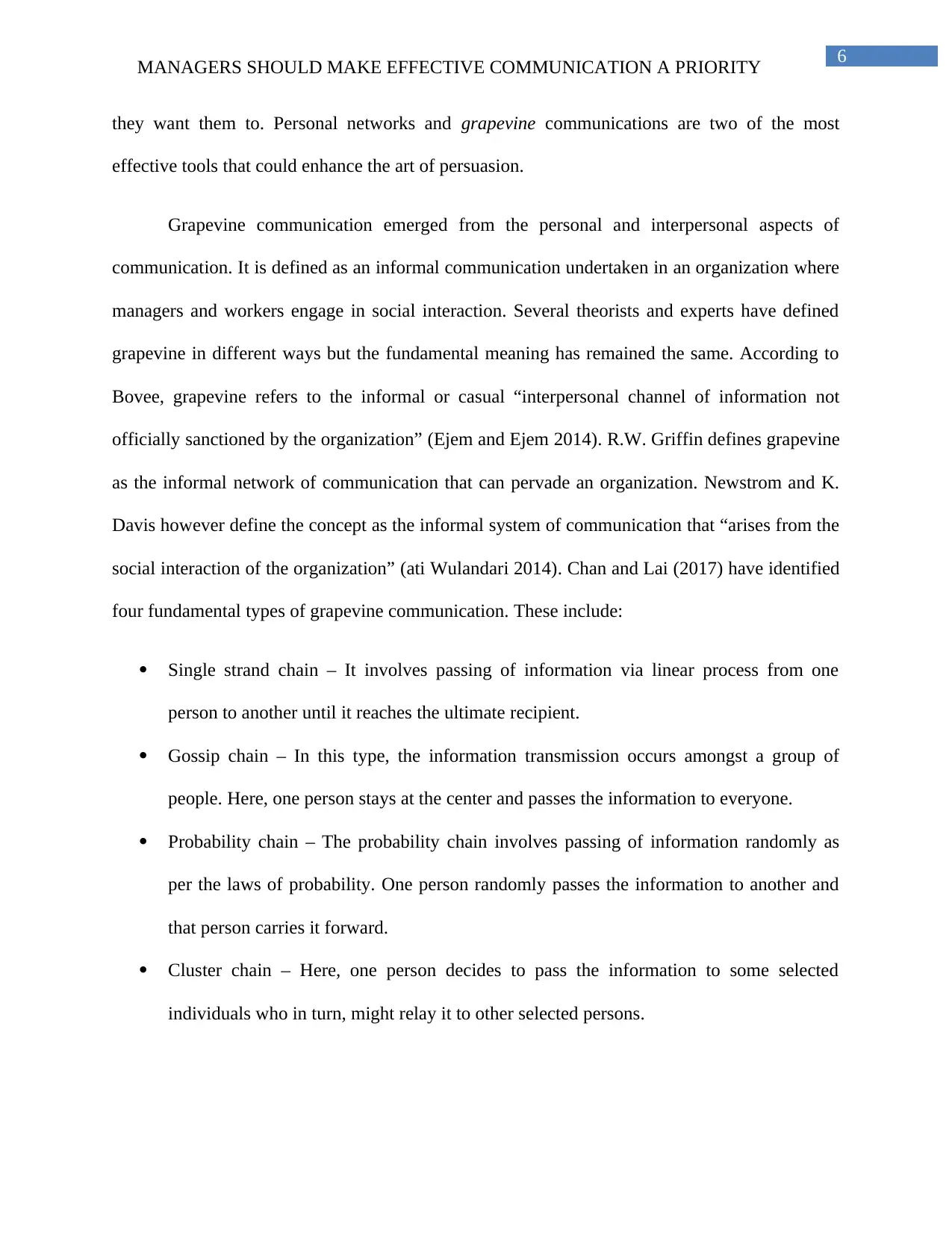
6
MANAGERS SHOULD MAKE EFFECTIVE COMMUNICATION A PRIORITY
they want them to. Personal networks and grapevine communications are two of the most
effective tools that could enhance the art of persuasion.
Grapevine communication emerged from the personal and interpersonal aspects of
communication. It is defined as an informal communication undertaken in an organization where
managers and workers engage in social interaction. Several theorists and experts have defined
grapevine in different ways but the fundamental meaning has remained the same. According to
Bovee, grapevine refers to the informal or casual “interpersonal channel of information not
officially sanctioned by the organization” (Ejem and Ejem 2014). R.W. Griffin defines grapevine
as the informal network of communication that can pervade an organization. Newstrom and K.
Davis however define the concept as the informal system of communication that “arises from the
social interaction of the organization” (ati Wulandari 2014). Chan and Lai (2017) have identified
four fundamental types of grapevine communication. These include:
Single strand chain – It involves passing of information via linear process from one
person to another until it reaches the ultimate recipient.
Gossip chain – In this type, the information transmission occurs amongst a group of
people. Here, one person stays at the center and passes the information to everyone.
Probability chain – The probability chain involves passing of information randomly as
per the laws of probability. One person randomly passes the information to another and
that person carries it forward.
Cluster chain – Here, one person decides to pass the information to some selected
individuals who in turn, might relay it to other selected persons.
MANAGERS SHOULD MAKE EFFECTIVE COMMUNICATION A PRIORITY
they want them to. Personal networks and grapevine communications are two of the most
effective tools that could enhance the art of persuasion.
Grapevine communication emerged from the personal and interpersonal aspects of
communication. It is defined as an informal communication undertaken in an organization where
managers and workers engage in social interaction. Several theorists and experts have defined
grapevine in different ways but the fundamental meaning has remained the same. According to
Bovee, grapevine refers to the informal or casual “interpersonal channel of information not
officially sanctioned by the organization” (Ejem and Ejem 2014). R.W. Griffin defines grapevine
as the informal network of communication that can pervade an organization. Newstrom and K.
Davis however define the concept as the informal system of communication that “arises from the
social interaction of the organization” (ati Wulandari 2014). Chan and Lai (2017) have identified
four fundamental types of grapevine communication. These include:
Single strand chain – It involves passing of information via linear process from one
person to another until it reaches the ultimate recipient.
Gossip chain – In this type, the information transmission occurs amongst a group of
people. Here, one person stays at the center and passes the information to everyone.
Probability chain – The probability chain involves passing of information randomly as
per the laws of probability. One person randomly passes the information to another and
that person carries it forward.
Cluster chain – Here, one person decides to pass the information to some selected
individuals who in turn, might relay it to other selected persons.
Paraphrase This Document
Need a fresh take? Get an instant paraphrase of this document with our AI Paraphraser

7
MANAGERS SHOULD MAKE EFFECTIVE COMMUNICATION A PRIORITY
In the views of Erden (2013), “power distance in organizations increases the amount of
grapevine through perceptions of uncertainty in workers”. The authors’ views demonstrate that
perceptions of uncertainty amongst workers lead to grapevine communication. It is therefore
important for managers to consider the criticality of grapevine communication and take steps
accordingly.
It is thus clear from all these definitions that the common theme in grapevine
communication is its informality. Prior to the emergence and popularity of the online social
networking sites, grapevine communication used to occur face-to-face. Singh (2013) explains
that the modern-day grapevine communication through online sites have been both a blessing
and a disguise for managers. The managers feel that internet familiarity has allowed the workers
to stay anonymous while spreading false news about the organization or earn recognition while
praising it. The ease of access to such technology has made grapevine communication as one of
the most influential aspects of communication in organizations today. Personal networks, on the
other hand, are the contacts built by humans with whom they interact at different intervals of life.
These contacts are built throughout the course of life by people with the help of persuasion
through personal and interpersonal communication. This process of forming personal networks
has been modified by the new age technology that includes the social media networks. Similar to
grapevine, people now build personal networks by creating Facebook groups or pages and
inviting people who share similar interests.
Grapevine and personal networks are two of the most important points for practicing the
art of persuasion. The workers within an organization with the capability of persuasion could
spread rumors about the management, which might lead to fault perceptions and failure of the
organization. The art of persuasion could benefit the organization if it is channeled in the right
MANAGERS SHOULD MAKE EFFECTIVE COMMUNICATION A PRIORITY
In the views of Erden (2013), “power distance in organizations increases the amount of
grapevine through perceptions of uncertainty in workers”. The authors’ views demonstrate that
perceptions of uncertainty amongst workers lead to grapevine communication. It is therefore
important for managers to consider the criticality of grapevine communication and take steps
accordingly.
It is thus clear from all these definitions that the common theme in grapevine
communication is its informality. Prior to the emergence and popularity of the online social
networking sites, grapevine communication used to occur face-to-face. Singh (2013) explains
that the modern-day grapevine communication through online sites have been both a blessing
and a disguise for managers. The managers feel that internet familiarity has allowed the workers
to stay anonymous while spreading false news about the organization or earn recognition while
praising it. The ease of access to such technology has made grapevine communication as one of
the most influential aspects of communication in organizations today. Personal networks, on the
other hand, are the contacts built by humans with whom they interact at different intervals of life.
These contacts are built throughout the course of life by people with the help of persuasion
through personal and interpersonal communication. This process of forming personal networks
has been modified by the new age technology that includes the social media networks. Similar to
grapevine, people now build personal networks by creating Facebook groups or pages and
inviting people who share similar interests.
Grapevine and personal networks are two of the most important points for practicing the
art of persuasion. The workers within an organization with the capability of persuasion could
spread rumors about the management, which might lead to fault perceptions and failure of the
organization. The art of persuasion could benefit the organization if it is channeled in the right
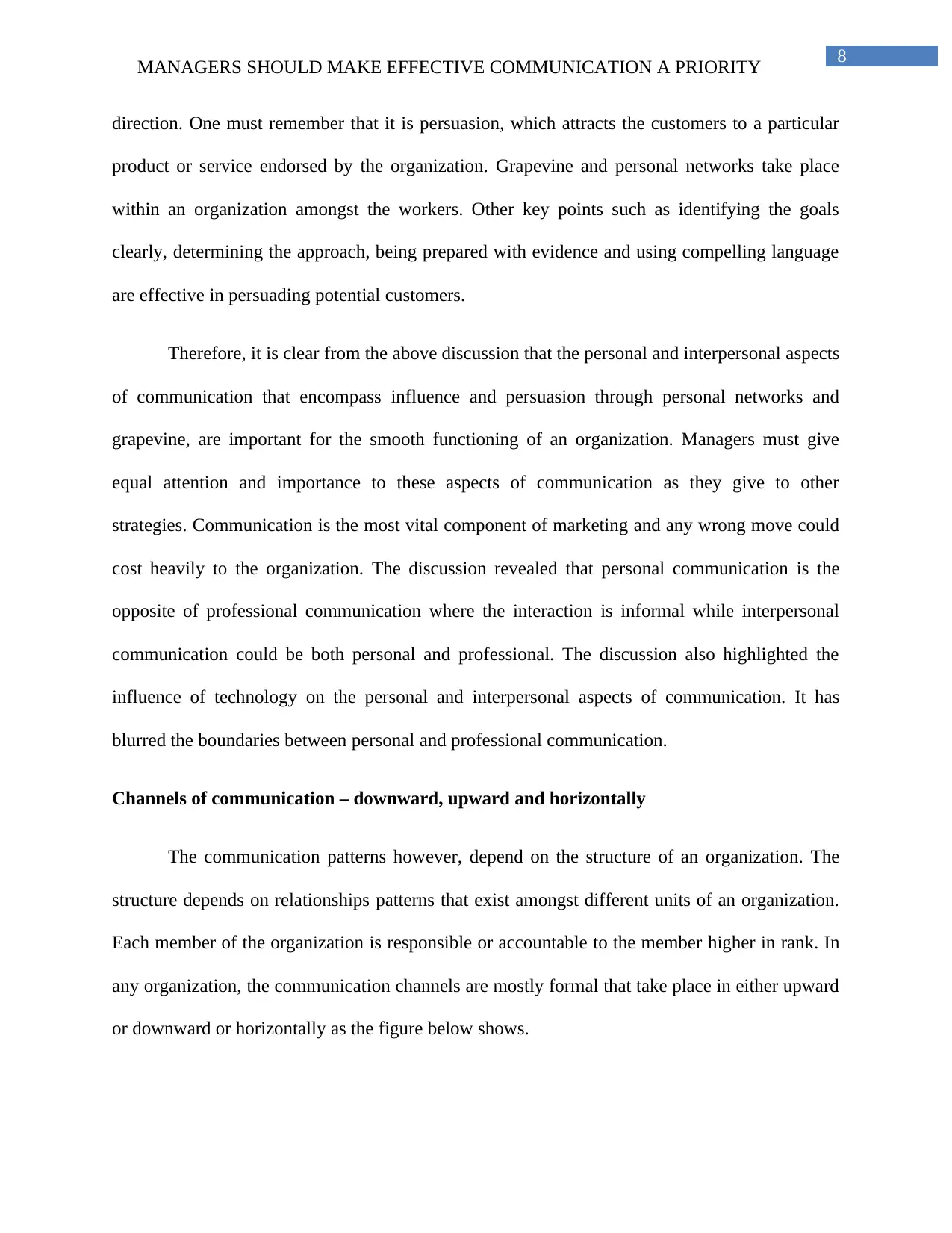
8
MANAGERS SHOULD MAKE EFFECTIVE COMMUNICATION A PRIORITY
direction. One must remember that it is persuasion, which attracts the customers to a particular
product or service endorsed by the organization. Grapevine and personal networks take place
within an organization amongst the workers. Other key points such as identifying the goals
clearly, determining the approach, being prepared with evidence and using compelling language
are effective in persuading potential customers.
Therefore, it is clear from the above discussion that the personal and interpersonal aspects
of communication that encompass influence and persuasion through personal networks and
grapevine, are important for the smooth functioning of an organization. Managers must give
equal attention and importance to these aspects of communication as they give to other
strategies. Communication is the most vital component of marketing and any wrong move could
cost heavily to the organization. The discussion revealed that personal communication is the
opposite of professional communication where the interaction is informal while interpersonal
communication could be both personal and professional. The discussion also highlighted the
influence of technology on the personal and interpersonal aspects of communication. It has
blurred the boundaries between personal and professional communication.
Channels of communication – downward, upward and horizontally
The communication patterns however, depend on the structure of an organization. The
structure depends on relationships patterns that exist amongst different units of an organization.
Each member of the organization is responsible or accountable to the member higher in rank. In
any organization, the communication channels are mostly formal that take place in either upward
or downward or horizontally as the figure below shows.
MANAGERS SHOULD MAKE EFFECTIVE COMMUNICATION A PRIORITY
direction. One must remember that it is persuasion, which attracts the customers to a particular
product or service endorsed by the organization. Grapevine and personal networks take place
within an organization amongst the workers. Other key points such as identifying the goals
clearly, determining the approach, being prepared with evidence and using compelling language
are effective in persuading potential customers.
Therefore, it is clear from the above discussion that the personal and interpersonal aspects
of communication that encompass influence and persuasion through personal networks and
grapevine, are important for the smooth functioning of an organization. Managers must give
equal attention and importance to these aspects of communication as they give to other
strategies. Communication is the most vital component of marketing and any wrong move could
cost heavily to the organization. The discussion revealed that personal communication is the
opposite of professional communication where the interaction is informal while interpersonal
communication could be both personal and professional. The discussion also highlighted the
influence of technology on the personal and interpersonal aspects of communication. It has
blurred the boundaries between personal and professional communication.
Channels of communication – downward, upward and horizontally
The communication patterns however, depend on the structure of an organization. The
structure depends on relationships patterns that exist amongst different units of an organization.
Each member of the organization is responsible or accountable to the member higher in rank. In
any organization, the communication channels are mostly formal that take place in either upward
or downward or horizontally as the figure below shows.
⊘ This is a preview!⊘
Do you want full access?
Subscribe today to unlock all pages.

Trusted by 1+ million students worldwide
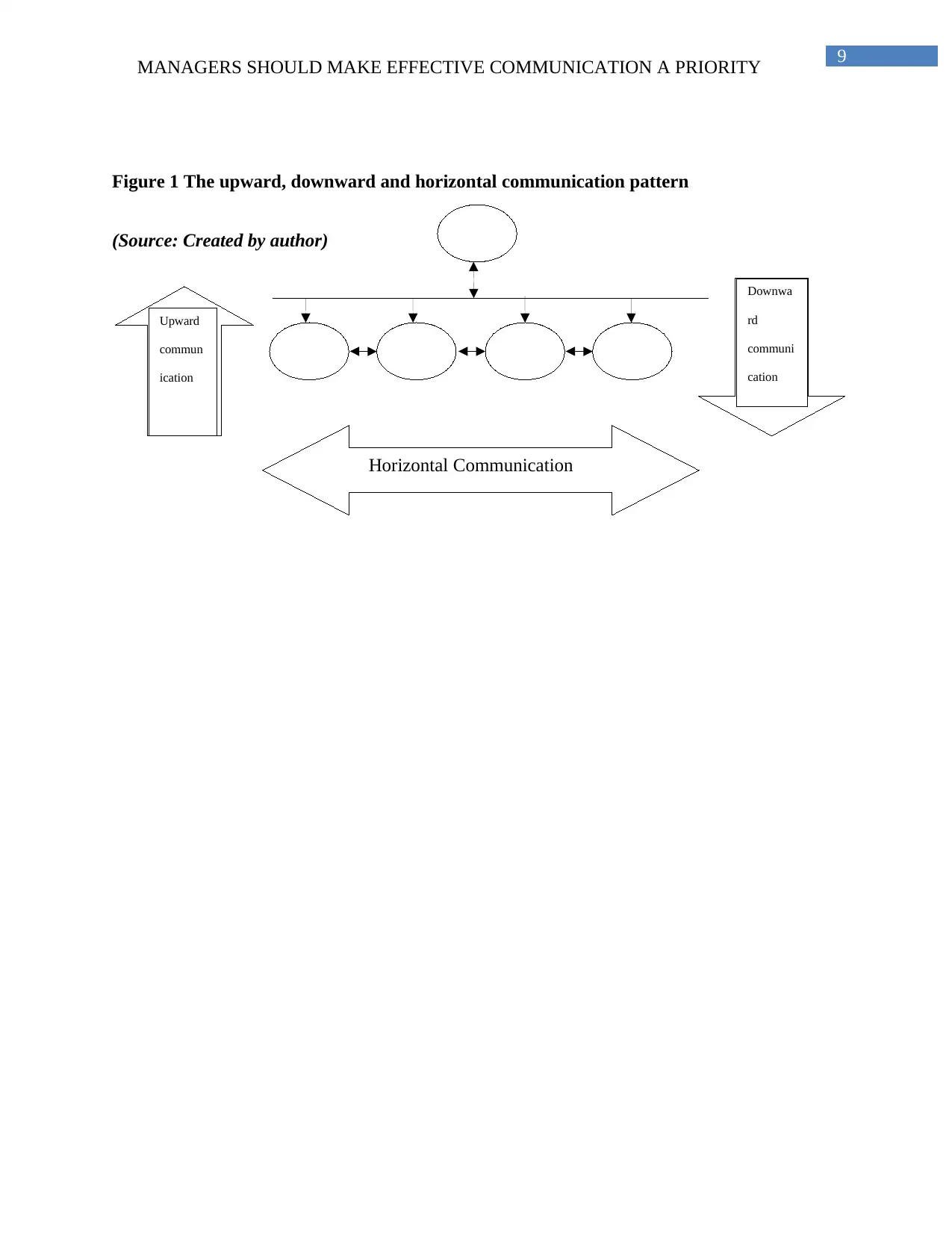
9
MANAGERS SHOULD MAKE EFFECTIVE COMMUNICATION A PRIORITY
Figure 1 The upward, downward and horizontal communication pattern
(Source: Created by author)
Horizontal Communication
Upward
commun
ication
Downwa
rd
communi
cation
MANAGERS SHOULD MAKE EFFECTIVE COMMUNICATION A PRIORITY
Figure 1 The upward, downward and horizontal communication pattern
(Source: Created by author)
Horizontal Communication
Upward
commun
ication
Downwa
rd
communi
cation
Paraphrase This Document
Need a fresh take? Get an instant paraphrase of this document with our AI Paraphraser

10
MANAGERS SHOULD MAKE EFFECTIVE COMMUNICATION A PRIORITY
However, informal communication channels are also present within organizations
examples of which include grapevine communication and personal networks, as mentioned in the
above section. The manager holds the key in the communication that flows within an
organization. The following sections shall discuss the establishment and maintenance of formal
and informal communication of an organization as a whole.
Formal communication channels
The communication channels that transmit information that include the policies, goals
and procedures of an organization are referred to as formal communication channels. Messages
in formal communication channels pursue a sequence of command. It means that the information
passes on to the manager and the manager in turn passes it on to his subordinates and the process
continues. One example of formal communication is an organization’s newsletter that provides
both employees and clients an idea of the organization’s vision and goals (Koc 2013). Apart
from that, the formal communication includes transmission of information in terms of the
memoranda, directions, reports and planned meetings. Formal communication channels also
include business plans, annual reports, employer’s manual, customer satisfaction survey and
review meetings. Sisko et al. (2014) shed light on the use of digital communication to strengthen
the formal communication channels in multinational corporations. The authors have found that
the role of digital internal communication (IC) especially in multinational organizations as
formal communication channels has increased. On the other hand, Berger and Iyengar (2013)
have found that formal communication channels “shape interpersonal communication and the
psychological drivers of word of mouth more broadly”. These facts reveal that formal
communication channels have undergone many changes over time from face-to-face to written
and digital.
MANAGERS SHOULD MAKE EFFECTIVE COMMUNICATION A PRIORITY
However, informal communication channels are also present within organizations
examples of which include grapevine communication and personal networks, as mentioned in the
above section. The manager holds the key in the communication that flows within an
organization. The following sections shall discuss the establishment and maintenance of formal
and informal communication of an organization as a whole.
Formal communication channels
The communication channels that transmit information that include the policies, goals
and procedures of an organization are referred to as formal communication channels. Messages
in formal communication channels pursue a sequence of command. It means that the information
passes on to the manager and the manager in turn passes it on to his subordinates and the process
continues. One example of formal communication is an organization’s newsletter that provides
both employees and clients an idea of the organization’s vision and goals (Koc 2013). Apart
from that, the formal communication includes transmission of information in terms of the
memoranda, directions, reports and planned meetings. Formal communication channels also
include business plans, annual reports, employer’s manual, customer satisfaction survey and
review meetings. Sisko et al. (2014) shed light on the use of digital communication to strengthen
the formal communication channels in multinational corporations. The authors have found that
the role of digital internal communication (IC) especially in multinational organizations as
formal communication channels has increased. On the other hand, Berger and Iyengar (2013)
have found that formal communication channels “shape interpersonal communication and the
psychological drivers of word of mouth more broadly”. These facts reveal that formal
communication channels have undergone many changes over time from face-to-face to written
and digital.
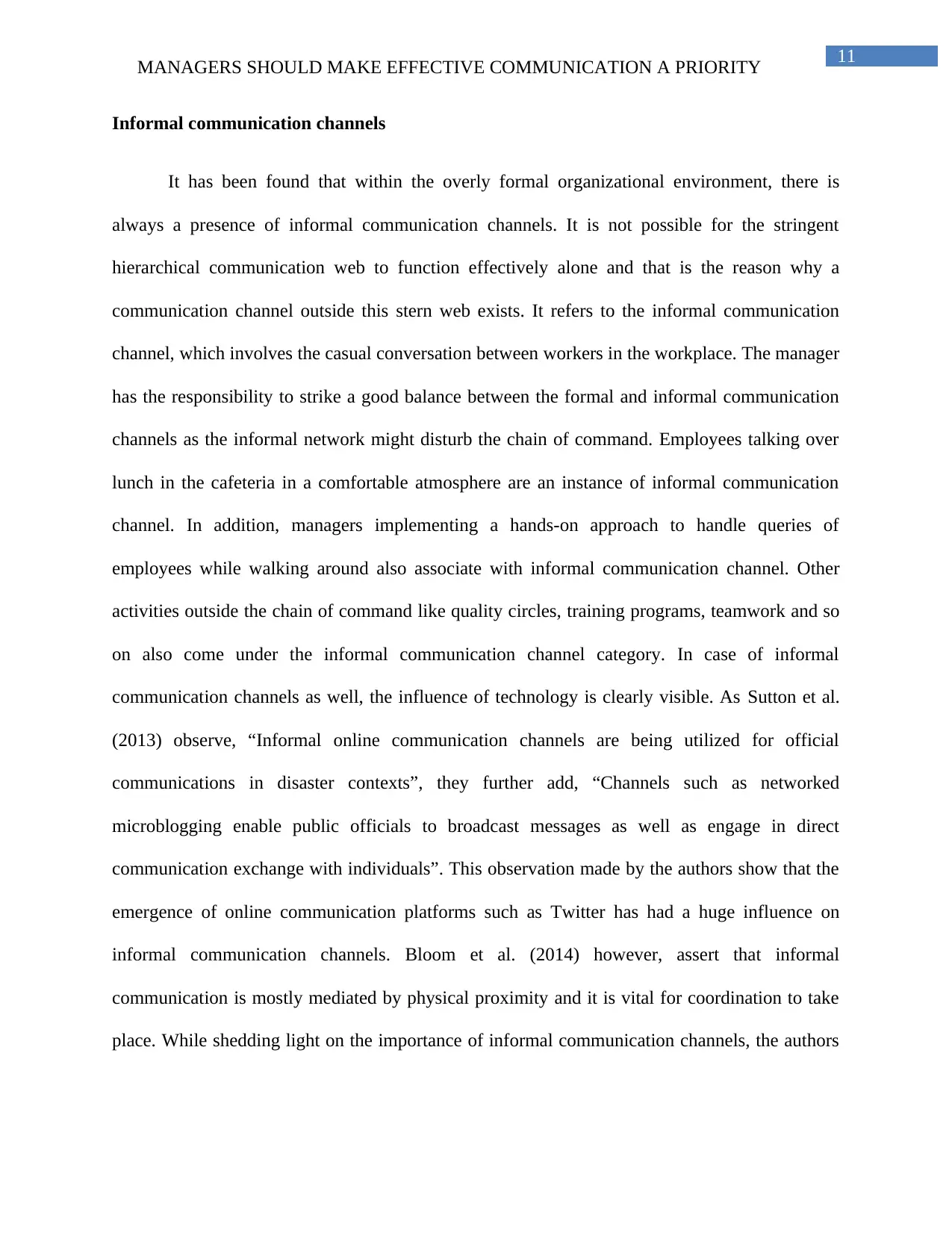
11
MANAGERS SHOULD MAKE EFFECTIVE COMMUNICATION A PRIORITY
Informal communication channels
It has been found that within the overly formal organizational environment, there is
always a presence of informal communication channels. It is not possible for the stringent
hierarchical communication web to function effectively alone and that is the reason why a
communication channel outside this stern web exists. It refers to the informal communication
channel, which involves the casual conversation between workers in the workplace. The manager
has the responsibility to strike a good balance between the formal and informal communication
channels as the informal network might disturb the chain of command. Employees talking over
lunch in the cafeteria in a comfortable atmosphere are an instance of informal communication
channel. In addition, managers implementing a hands-on approach to handle queries of
employees while walking around also associate with informal communication channel. Other
activities outside the chain of command like quality circles, training programs, teamwork and so
on also come under the informal communication channel category. In case of informal
communication channels as well, the influence of technology is clearly visible. As Sutton et al.
(2013) observe, “Informal online communication channels are being utilized for official
communications in disaster contexts”, they further add, “Channels such as networked
microblogging enable public officials to broadcast messages as well as engage in direct
communication exchange with individuals”. This observation made by the authors show that the
emergence of online communication platforms such as Twitter has had a huge influence on
informal communication channels. Bloom et al. (2014) however, assert that informal
communication is mostly mediated by physical proximity and it is vital for coordination to take
place. While shedding light on the importance of informal communication channels, the authors
MANAGERS SHOULD MAKE EFFECTIVE COMMUNICATION A PRIORITY
Informal communication channels
It has been found that within the overly formal organizational environment, there is
always a presence of informal communication channels. It is not possible for the stringent
hierarchical communication web to function effectively alone and that is the reason why a
communication channel outside this stern web exists. It refers to the informal communication
channel, which involves the casual conversation between workers in the workplace. The manager
has the responsibility to strike a good balance between the formal and informal communication
channels as the informal network might disturb the chain of command. Employees talking over
lunch in the cafeteria in a comfortable atmosphere are an instance of informal communication
channel. In addition, managers implementing a hands-on approach to handle queries of
employees while walking around also associate with informal communication channel. Other
activities outside the chain of command like quality circles, training programs, teamwork and so
on also come under the informal communication channel category. In case of informal
communication channels as well, the influence of technology is clearly visible. As Sutton et al.
(2013) observe, “Informal online communication channels are being utilized for official
communications in disaster contexts”, they further add, “Channels such as networked
microblogging enable public officials to broadcast messages as well as engage in direct
communication exchange with individuals”. This observation made by the authors show that the
emergence of online communication platforms such as Twitter has had a huge influence on
informal communication channels. Bloom et al. (2014) however, assert that informal
communication is mostly mediated by physical proximity and it is vital for coordination to take
place. While shedding light on the importance of informal communication channels, the authors
⊘ This is a preview!⊘
Do you want full access?
Subscribe today to unlock all pages.

Trusted by 1+ million students worldwide
1 out of 26
Related Documents
Your All-in-One AI-Powered Toolkit for Academic Success.
+13062052269
info@desklib.com
Available 24*7 on WhatsApp / Email
![[object Object]](/_next/static/media/star-bottom.7253800d.svg)
Unlock your academic potential
Copyright © 2020–2025 A2Z Services. All Rights Reserved. Developed and managed by ZUCOL.



